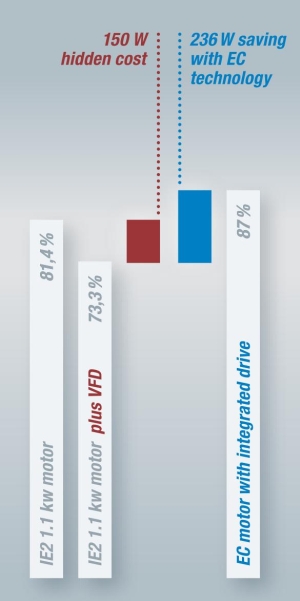In an effort to reduce our Carbon emissions many Governments around the world encourage the use of variable frequency drives (VFD) with induction motors. This decision is made on the understanding that significant energy savings are achieved through the fan and pump ‘power law’. The flaw in this decision is the oversight of alternative technologies such as EC motors and that there are hidden costs with variable frequency drives.
The power law theory states that the power consumed by the impeller is proportional to the cube power of the change in speed; reducing the impeller speed by 50 per cent reduces the power input to 12.5 per cent. If the fan speed can be modulated to meet a demand then significant energy savings can be achieved. This law should be used with care as theory does not occur in practice. It assumes turbulent air flow throughout the control range, and this is unlikely, and it does not consider fixed losses within the motor and drive. Significant savings can still be achieved, but not quite as much as the law would indicate.There are some hidden costs with VFD’s, for example they increase motor losses. IEC60034-31, selection of energy-efficient motors including variable speed applications, advises that the addition of a VFD increase motor losses by 2 to 5 per cent; in adverse circumstances it can increase motor losses up to 15 to 20 per cent. The VFD also has its own losses with small drives being less efficient than large drives. The losses are also dependant on the drive switching frequency. The loss is less with low frequency switching, but this produces mechanical noise from the motor. The drive is therefore normally set at a high switching frequency but this increases its losses, for example a 1.1 kW drive is typically 95 per cent efficient at low and 92 per cent at high switching frequency. Another loss overlooked is that of power factor correction.
When these losses are added together and compared to alternative technology the true cost is revealed. Whereas EC motors include variable speed technology and power factor correction the associated losses are not hidden, but shown within the overall figure. For example a 1.1 kW 4 pole motor a high efficient (IE2) induction motor is 81.4 per cent efficient. When the VFD, filter and increased motor losses are added this leads to an overall efficiency of 73.3 per cent, a hidden cost of 150 W. A comparable EC motor is 87 per cent and saves 236 W, see figure 1. With a theoretical energy reduction of 78.5 per cent when the fan is reduced to 50 per cent then it is understandable why variation of fan speed is encouraged through legislation. However this should not be restricted to variable frequency drives as there are hidden costs that are not concealed with alternative technology, such as EC technology. Which saves even more
energy while being more efficient and infinitely adjustable.



Excellent reading.
Great product ,fantastic technology ,should rule the world.